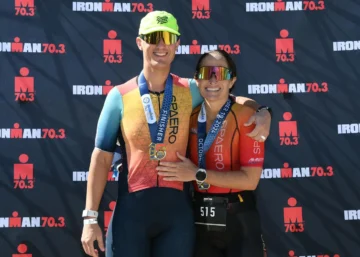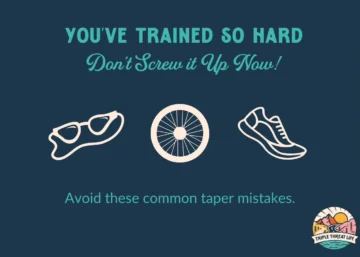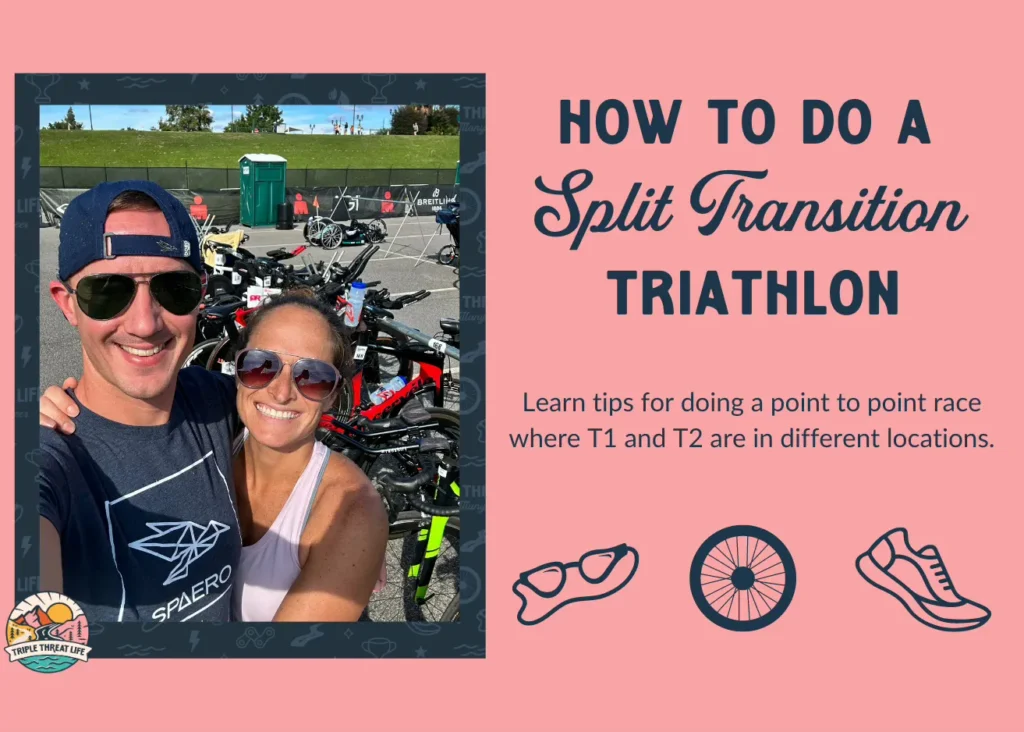
Most of us are familiar with the set up of a traditional triathlon.
Swim- (T1)- Bike- (T2)- Run
For newcomers to the sport, T1 stands for transition 1. This is where you will swap out your swim gear, grab your bike, and head out on course. T2, or transition 2, is where you drop off your bike, change into running shoes and start the final leg of the race.
The transition area is typically set up in central location with bike racks and areas for athletes to set up all their gear.
However, there are many Ironman triathlons with split transitions, when T1 and T2 are located in different places. This is often done when the swim is in a different area than the run, or the bike is point-to-point, instead of a loop.
Doing a triathlon with split transitions will require some extra planning on your part. But although it might seem intimidating at first, many athletes actually think it’s easier.
I’ve done two Ironman triathlons with split transitions: 70.3 North Carolina and the 70.3 World Championship in St. George, and they both had slightly different procedures. We will cover both, and since 70.3 North Carolina is coming up in just a few weeks, it will serve as a great refresher for those doing the race!
What’s up with all these different bags?…
At 70.3 Ironman events, you will be given three different bags during athlete check in.
- White morning clothes bag
- Blue bike bag
- Red run bag
*TIP: See how they’re color-coded? Blue is for bike and red is for run.
The white morning clothes bag is used to store items at the swim start that you might want at the finish line, like a sweatshirt, pair of shoes, or sunglasses. Many athletes using the morning clothes bag as a “swim bag” that they use to carry their wetsuit, goggles, and water bottle to the swim start. Then, when it’s time to race, you put your personal items in the bag and drop it off in a designated zone so volunteers can take it to the finish line.
The bike bag is used to store gear you will need for the bike, like your helmet, cycling shoes, and socks. Similarly, the run bag is used to hold your running shoes, hat, nutrition, race belt, ect.
Sounds simple enough, right?
It is, in theory. But the reason why split transitions tend to make athletes nervous is because gear bags are typically pre-packed and dropped off prior to the race. For example, at 70.3 North Carolina, you will drop off your bike bag at T1 and run bag at T2 the day before the race. Sometimes you’re allowed access to T1 bags on race morning, but typically not T2, because of the time it would take to get back to the swim start.
How to pack gear bags

In order to ensure that you don’t forget anything in your transition bags, my best tip is to lay everything out on a towel, just like you would underneath your bike at a regular triathlon.
Then, go through your checklist and visually cross off each item that you will need for the swim, bike, and run. All that’s left is to separate and pack the gear into the appropriate bags.
Be thoughtful about how you pack your gear bags. Don’t just throw everything inside. The goal is to make it as easy as possible to find what you need when you’re in a hurry and out of breath.
Place items in the bags in the order you plan to put them on. If you’re wearing socks, roll them up and stuff them inside your cycling shoes. Unbuckle the strap on your helmet and place it upside down in the bag. Take your sunglasses out of the case and place them inside your helmet.
If you plan to wear a hat for the run, create a package with your race belt and nutrition inside, so you can run out of transition and put things on as you go.
TIP: For a fast transition, don’t do anything standing still that you could do on the move. We place gels and salt tabs in a large Ziplock bag so we can grab and go out of transition. Then, we put things into our pockets while we’re running.
Where do I find my gear bags during the race?
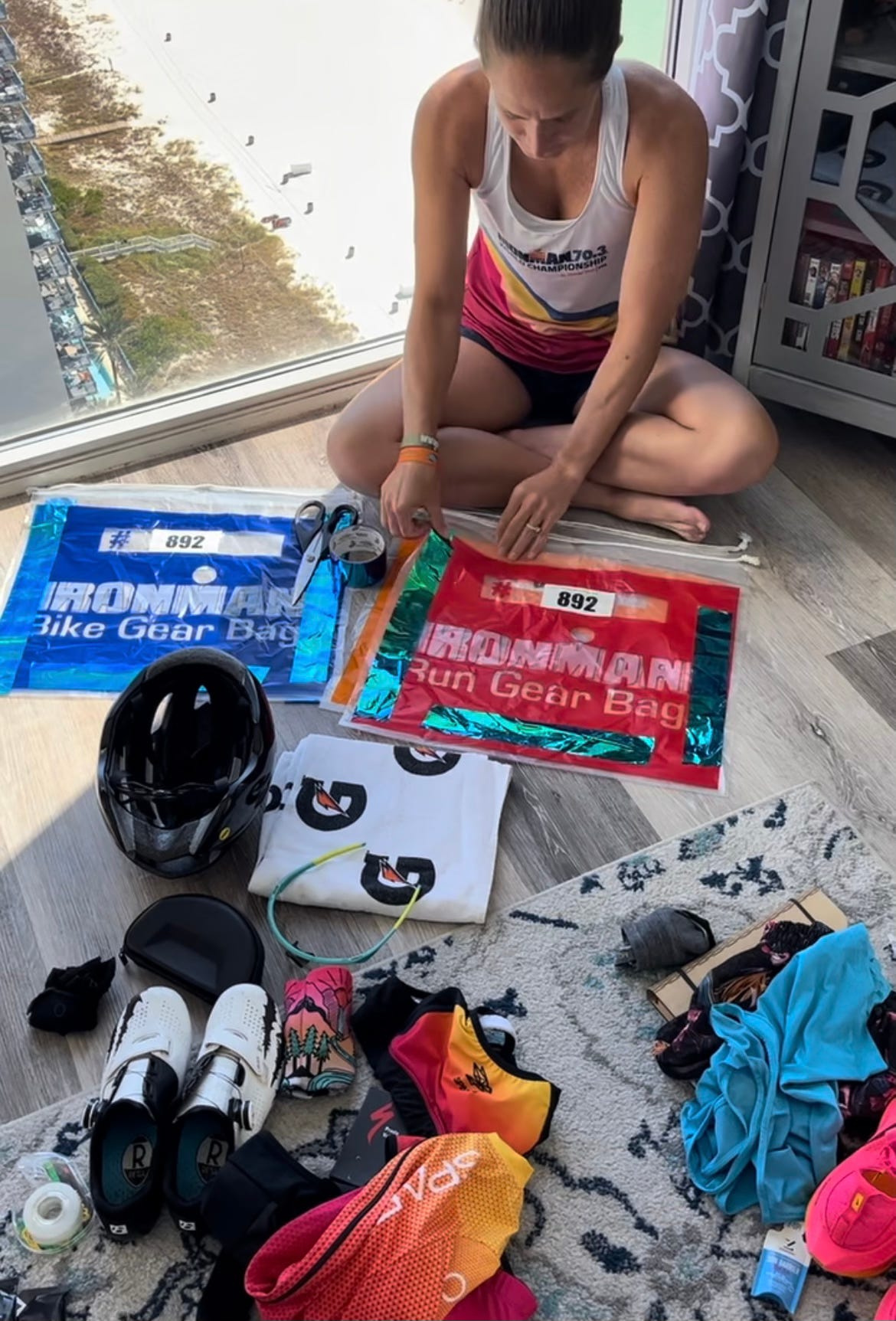
The white morning clothes bag goes with you to the swim start, but the bike and run bags will be waiting for you at T1 and T2. The procedure varies depending on the race.
For example, at the 70.3 World Championship, all bike bags hung together on a large rack at the exit of the swim before we could enter T1 to get our bikes. At 70.3 North Carolina, individual bike bags hang on the rack next to your bike.
The same goes for the run. If you’re at a big race where they have volunteers grabbing bikes to rack them for you, then T2 bags will be hung together on a large rack that you can access before you head out on the run course.
If it’s a race like 70.3 North Carolina, where you rack your own bike, then your T2 bag will be waiting for you at your transition spot.
If you’re competing in a race that has a large bag rack that all athletes share (also often done in full Ironman races that have regular transitions) it can be difficult to find your bag among thousands of others that look the same. You can add something colorful to your bags, like bright tape or even stickers. However, don’t hang anything off your bag, because officials will ask you to remove it.
*I’ve written articles for both IRONMAN and Triathlete Magazine on this topic and confirmed that officials will not ask you to remove tape or stickers from your gear bags. However, if a volunteer doesn’t understand the rules and asks you to make a change, it’s always best to comply rather than argue.
PRO TIP: One of my friends, pro triathlete Grace Alexander, once told me that she uses a highlighter to color the strings of her bag! I did this at Ironman Florida last year and it worked great. Also, you will be given race number stickers to put on your bags. To ensure they don’t fall off, I use clear packing tape over the top. Also, we shorten the strings on our bags so they hang just a bit higher than all the rest, which helps them stand out on the rack.
There’s one important thing to keep in mind when doing a split transition triathlon. Once you’ve changed from your swim gear into your cycling gear in T1, you must put your swim gear into your T1 bag. Then, it will either hang by your bike spot, or you drop it in a designated zone, depending on the race. That’s how it gets to the finish line.
Similarly, once you’ve changed out of your cycling gear and into your running attire in T2, you must put your cycling gear back into the T2 bag and place it in the appropriate area.
How to execute a split transition
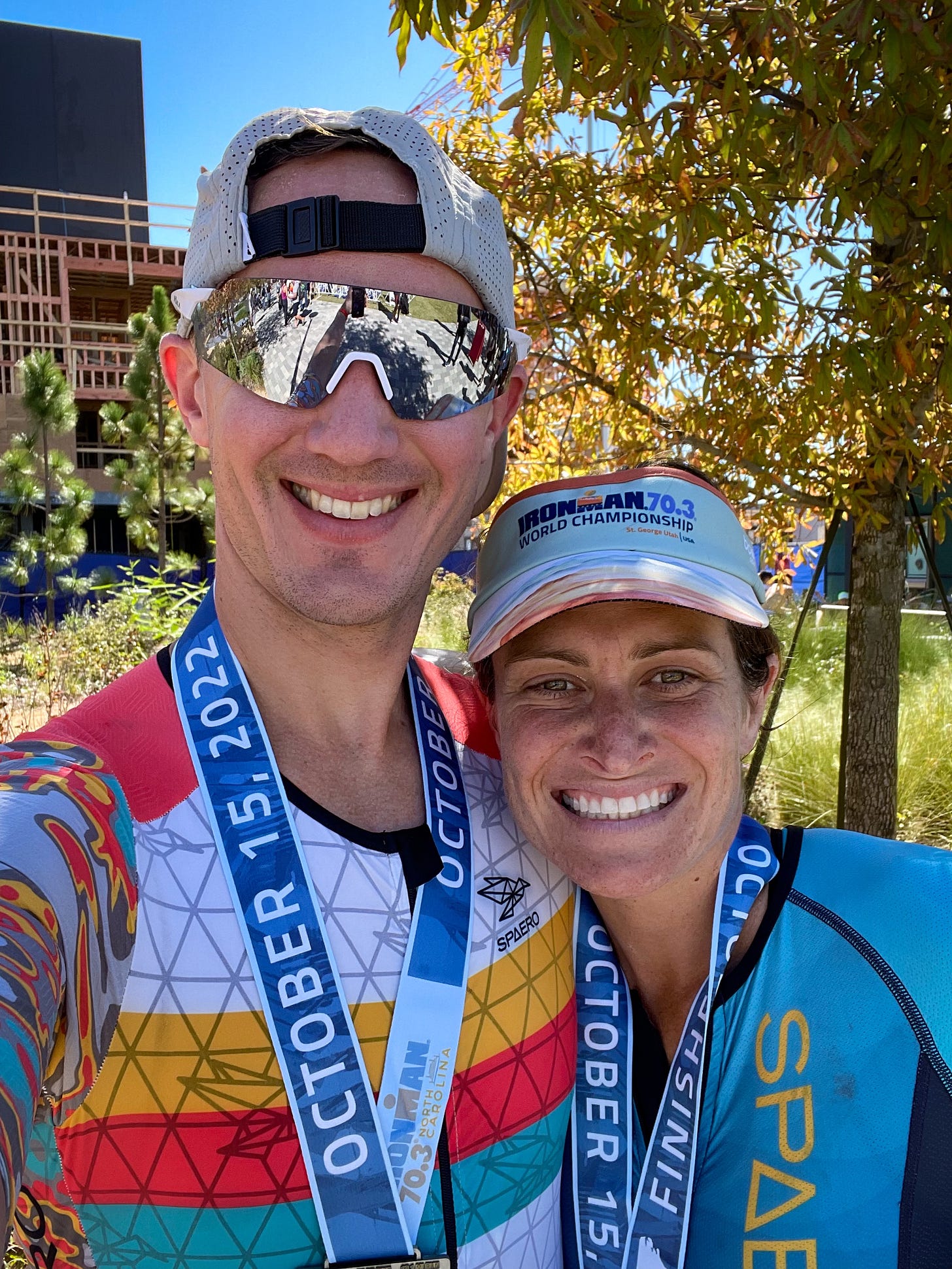
The best thing you can do to ensure a swift and stress-free transition is to practice. Before every race, we lay out our gear for T1 and T2 and practice going through the motions. We visualize coming out of the swim, removing our goggles, cap, and wetsuit. Then, we put on our socks, cycling shoes, helmet, and sunglasses.
Next, we practice T2 by removing our cycling gear and putting on running shoes, grabbing our hat, race belt, sunglasses, and nutrition. Make a game out of it! We even time ourselves to see how fast we can get. By practicing, you can find ways to shave off valuable time without expending any extra effort.
Another helpful strategy is visualization. During a race when adrenaline is high, it’s easy to forget how to do the simplest of things. By running through each step of transition in your mind, it will make the process feel like second nature on race day.
Whether it’s a split transition or a regular transition, there’s one part of our pre-race prep that we never skip. The day before, or on race morning, we do a pre-race walk through. We scope out transition, find our bike spot, and look for landmarks to help with navigation.
We locate the swim in and bike out arches, as well as bike in and run out areas and the mount and dismount line. Then, we physically walk through the flow of transition in order to determine the best path and cement it in our minds.
TIP: Look for landmarks that won’t move by race morning, like a banner, tree, or building. For bike racks and bag racks, count the supports they sit on so you know you’re in section 5, for example.
To recap, here are the keys to executing a split transition triathlon.
1- Planning: Lay out all your swim, bike, and run gear, go through your checklist, and divide into the appropriate gear bags. Know whether your race uses a large rack for all athletes or if your bag will hang on your bike rack.
2- Practice: Practice T1 and T2 to fine-tune transition skills and create muscle memory. Visualize going though each part of the process. Do a pre-race walkthrough to acquaint yourself with the flow of transition and locate helpful landmarks.
3- Execution: Pack your gear bags thoughtfully so they’re organized. Remember to put the gear you’re done with back into the bags so it can be transported to the finish line.
With planning, practice, and proper execution, you will get through your next triathlon with split transitions, stress-free.
If you found this post helpful, please share it with someone who might benefit. This helps us reach other athletes.
